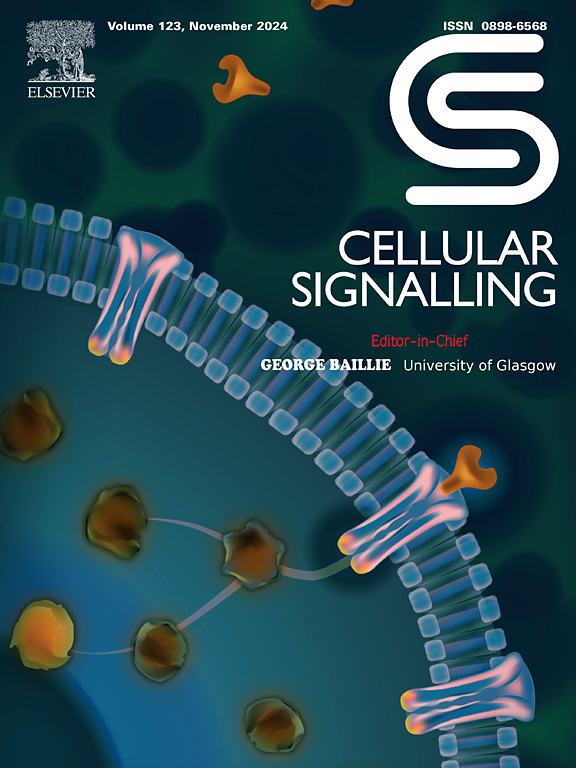Lipopolysaccharide-regulated RNF31/NRF2 axis in colonic epithelial cells mediates homeostasis of the intestinal barrier in ulcerative colitis
IF 3.7
2区 生物学
Q2 CELL BIOLOGY
引用次数: 0
Abstract
Background
Although previous studies have shown that the Ring Finger Protein 31 (RNF31) gene confers susceptibility to inflammatory disease and colorectal cancer, the exact function of this protein in ulcerative colitis (UC) has not been determined.
Methods
A mouse dextran sulfate sodium (DSS)-induced experimental colitis model was used to study RNF31 and NRF2 in colitis. RNF31 silencing or overexpression in vitro was applied to address the role of RNF31 in colonic mucosal barrier damage. Immunohistochemistry and silico analysis was performed to investigate the expression of RNF31 via taking advantage of UC tissue samples and Gene Expression Omnibus (GEO) data, respectively. The cycloheximide (CHX)-chase experiment and Co-Immunoprecipitation (Co-IP) assays were conducted to explore the association of RNF31 protein with NRF2 and P62.
Results
RNF31 is highly expressed in UC patients, in inflamed murine colon induced DSS and Lipopolysaccharide (LPS)-treated epithelial cells, while the express of NRF2 was Tabdecreased. RNF31-knockdown mice in the DSS-induced colitis model had a less severe phenotype, which was associated with a more integrated barrier of colon epithelial cells. While depletion of NRF2 in colitis model exacerbated intestinal inflammation. Mechanistically, RNF31 promoted the degradation of NRF2 by regulating its ubiquitination. Upon stimulation by RNF31, NRF2 is K63 ubiquitinated, which is associated with the C871 residue of RNF31. Moreover, downregulated NRF2 mediates inflammation by promoting the secretion of IL1β and IL18, leading to damage of the intestinal barrier. Upon LPS stimulation, the interaction of the PUB domain of RNF31 with the UBA domain of P62 increased, resulting in decreased degradation of the RNF31 protein via autophagy.
Conclusion
Overall, depletion of RNF31 effectively relieves DSS-induced colitis in mice by inhibiting NRF2 degradation, suggesting that RNF31 may be a potential therapy for human ulcerative colitis.
结肠上皮细胞中受脂多糖调控的 RNF31/NRF2 轴介导了溃疡性结肠炎肠屏障的平衡。
背景:尽管先前的研究表明环指蛋白 31(RNF31)基因易导致炎症性疾病和结直肠癌,但该蛋白在溃疡性结肠炎(UC)中的确切功能尚未确定:方法:采用小鼠葡聚糖硫酸钠(DSS)诱导的实验性结肠炎模型研究 RNF31 和 NRF2 在结肠炎中的作用。方法:利用小鼠葡聚糖硫酸钠(DSS)诱导的实验性结肠炎模型研究 RNF31 和 NRF2 在结肠炎中的作用,并在体外应用 RNF31 沉默或过表达来探讨 RNF31 在结肠粘膜屏障损伤中的作用。研究人员利用 UC 组织样本和基因表达总库(Gene Expression Omnibus,GEO)数据,分别对 RNF31 的表达进行了免疫组化和硅学分析。研究人员还进行了环己亚胺(CHX)-酶实验和共免疫沉淀(Co-IP)实验,以探讨RNF31蛋白与NRF2和P62的关联:结果:RNF31在UC患者、DSS诱导的炎症小鼠结肠和脂多糖(LPS)处理的上皮细胞中高表达,而NRF2的表达量则下降。在 DSS 诱导的结肠炎模型中,剔除 RNF31 的小鼠表型较轻,这与结肠上皮细胞的屏障更加完整有关。而在结肠炎模型中消耗 NRF2 会加剧肠道炎症。从机理上讲,RNF31通过调节NRF2的泛素化来促进其降解。在 RNF31 的刺激下,NRF2 被 K63 泛素化,这与 RNF31 的 C871 残基有关。此外,下调的 NRF2 通过促进 IL1β 和 IL18 的分泌来介导炎症,导致肠道屏障受损。在 LPS 刺激下,RNF31 的 PUB 结构域与 P62 的 UBA 结构域的相互作用增加,导致 RNF31 蛋白通过自噬降解的减少:总之,通过抑制NRF2降解,消耗RNF31可有效缓解DSS诱导的小鼠结肠炎,这表明RNF31可能是人类溃疡性结肠炎的一种潜在疗法。
本文章由计算机程序翻译,如有差异,请以英文原文为准。
求助全文
约1分钟内获得全文
求助全文
来源期刊

Cellular signalling
生物-细胞生物学
CiteScore
8.40
自引率
0.00%
发文量
250
审稿时长
27 days
期刊介绍:
Cellular Signalling publishes original research describing fundamental and clinical findings on the mechanisms, actions and structural components of cellular signalling systems in vitro and in vivo.
Cellular Signalling aims at full length research papers defining signalling systems ranging from microorganisms to cells, tissues and higher organisms.
 求助内容:
求助内容: 应助结果提醒方式:
应助结果提醒方式:


